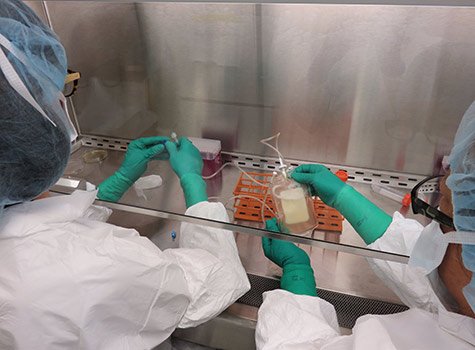The necessary surgery is effective but invasive. For surgeries like these, science fiction authors have long dreamt of shrinking surgeons to mere millimeters to allow them to navigate interior passageways of the body instead of cutting large access holes. Arriving at problem sites, the fictional physicians might provide targeted drug delivery or surgical intervention.
Aaron T. Becker, electrical and computer engineering professor at the UH Cullen College of Engineering, is working collaboratively to deliver a robotic version of this microsurgeon. His submission to ICRA, the flagship conference of the IEEE Robotics and Automation Society in Seattle, Wash., was nominated for best conference paper and best medical robotics paper.
With collaborators Pierre E. Dupont, visiting professor of surgery at Harvard Medical School, and Ouajdi Felfoul, Harvard Medical School postdoctoral fellow at Boston Children’s Hospital, Becker plans to present, «Toward Tissue Penetration by MRI-powered Millirobots Using a Self-Assembled Gauss Gun» at the conference this month.
«Hydrocephalus, among other conditions, is a candidate for correction by our millirobots because the ventricles are fluid-filled and connect to the spinal canal," Becker said. «Our noninvasive approach would eventually require simply a hypodermic needle or lumbar puncture to introduce the components into the spinal canal, and the components could be steered out of the body afterwards.»
Using a clinical Magnetic Resonance Imaging (MRI) scanner, the researchers map routes to problem sites on high-quality brain images to deliver medical interventions with tiny, maneuverable robotic components. Becker and his colleagues hack the scanners to enable them to use the MRI’s own magnetic fields to push the small metal-filled robots. The team has already demonstrated use of magnetic forces to actuate needle-biopsy robots and to walk robots around an MRI.
However, MRI scanners are not designed to push robots around, so they cannot apply enough force to pierce tissues or insert needles. These weak forces are a significant obstacle to using the MRI for medical interventions.
A toy called a Gauss gun inspired Becker’s solution. The toy offers surprising results from a simple row of steel balls separated intermittently by several high-powered magnets. A single steel ball rolled toward one end of the row sets off a chain reaction when it smashes into the first ball. Sequentially, each steel ball smashes into the next until the last ball flies forward at a speed much faster than the initial ball’s. Spacing between the magnets and steel balls stores potential energy, which the first ball converts to speed when it hits one end.
Similarly, the medical robot is a barrel self-assembled from smaller, separate components that navigate easily through the body. Each barrel component is 3D-printed from high-impact plastic with slender titanium rod spacers that separate two steel balls. Magnets are unnecessary because the MRI scanners magnetize the steel balls. The first component is a specialized delivery vehicle equipped with an 18-gauge needle tip used to pierce membranes or deliver drugs. The final component is a trigger with a long spacer so the two steel balls are only weakly attracted to each other. The approaching trigger is attracted to the barrel, which unleashes the stored potential energy and fires the other end component towards the target. Additional barrel components increase firing speeds.
«The work is still conceptual, but we have demonstrated the procedure working on plastic, fluid-filled containers, or phantoms, inside an unmodified clinical MRI scanner," Becker said. «The benefit of our research is that we can now create clinically relevant forces inside a standard MRI scanner, using just the MRI magnetic field.»
Becker’s ongoing work focuses on exploring clinical context, miniaturizing the device and optimizing material selection.
BY: Elena Watts
https://www.egr.uh.edu/news/201505/paper-medical-mri-powered-millirobots-attracts-conference-attention
